Inclusive Practice in Education: Strategies and Benefits
VerifiedAdded on 2023/06/15
|9
|2682
|240
Report
AI Summary
This report provides a comprehensive overview of inclusive practices in education, emphasizing the importance of creating learning environments that promote equality, diversity, and inclusion. It reviews the key features and benefits of inclusive learning, highlighting how it enhances student motivation, respect, and collaboration. The report also explores various strategies for promoting equality and diversity, including multiculturalism, human rights, and anti-discrimination policies. Furthermore, it discusses methods for fostering inclusion, such as providing opportunities for students to share their views, appreciating diverse perspectives, and understanding student needs. The report concludes by examining strategies for effective liaison between professionals involved in inclusive practice, emphasizing the importance of meetings, collaboration, and communication to support student achievement and create a positive learning environment. This resource is available on Desklib, offering students access to a wealth of study tools and solved assignments.
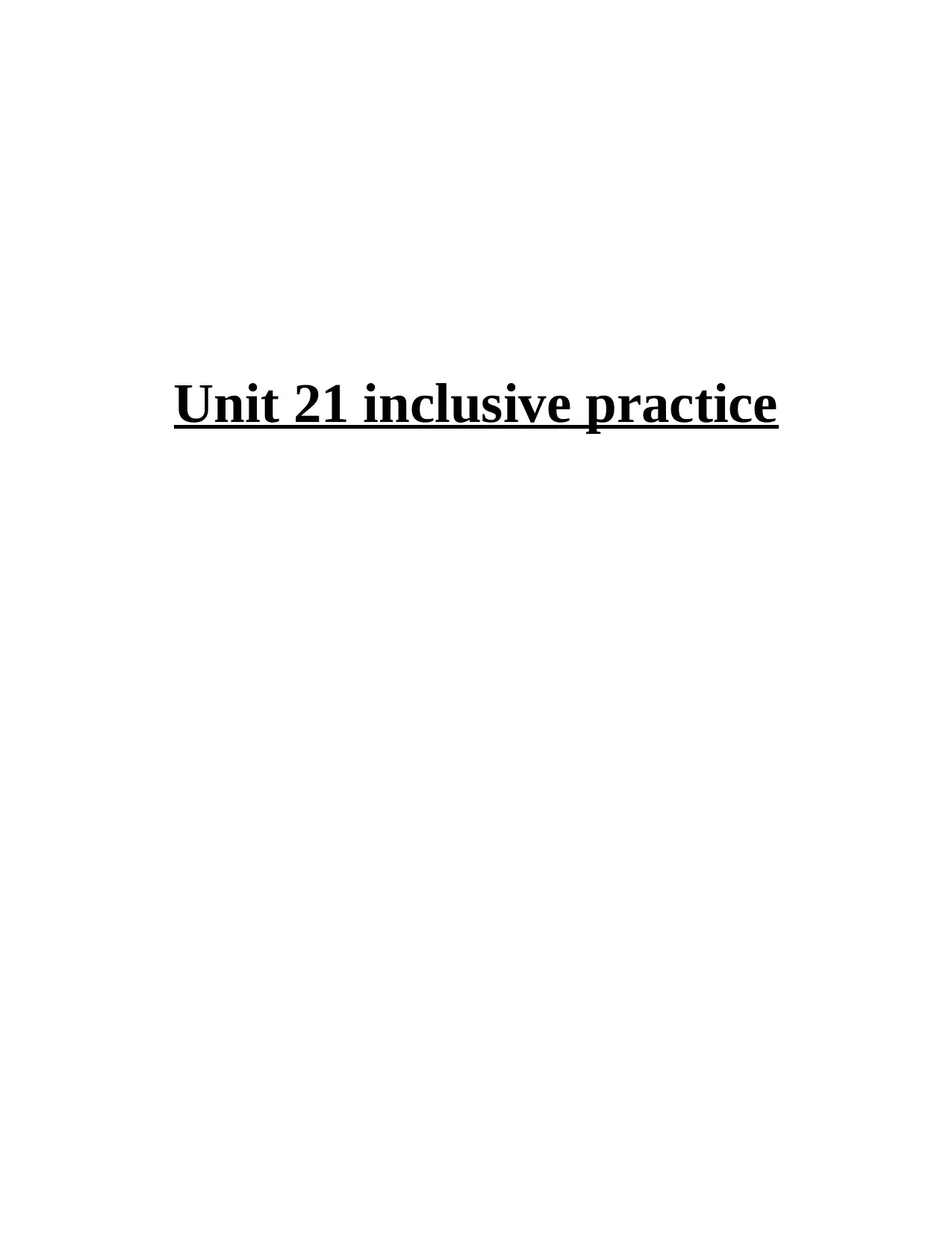
Unit 21 inclusive practice
Paraphrase This Document
Need a fresh take? Get an instant paraphrase of this document with our AI Paraphraser
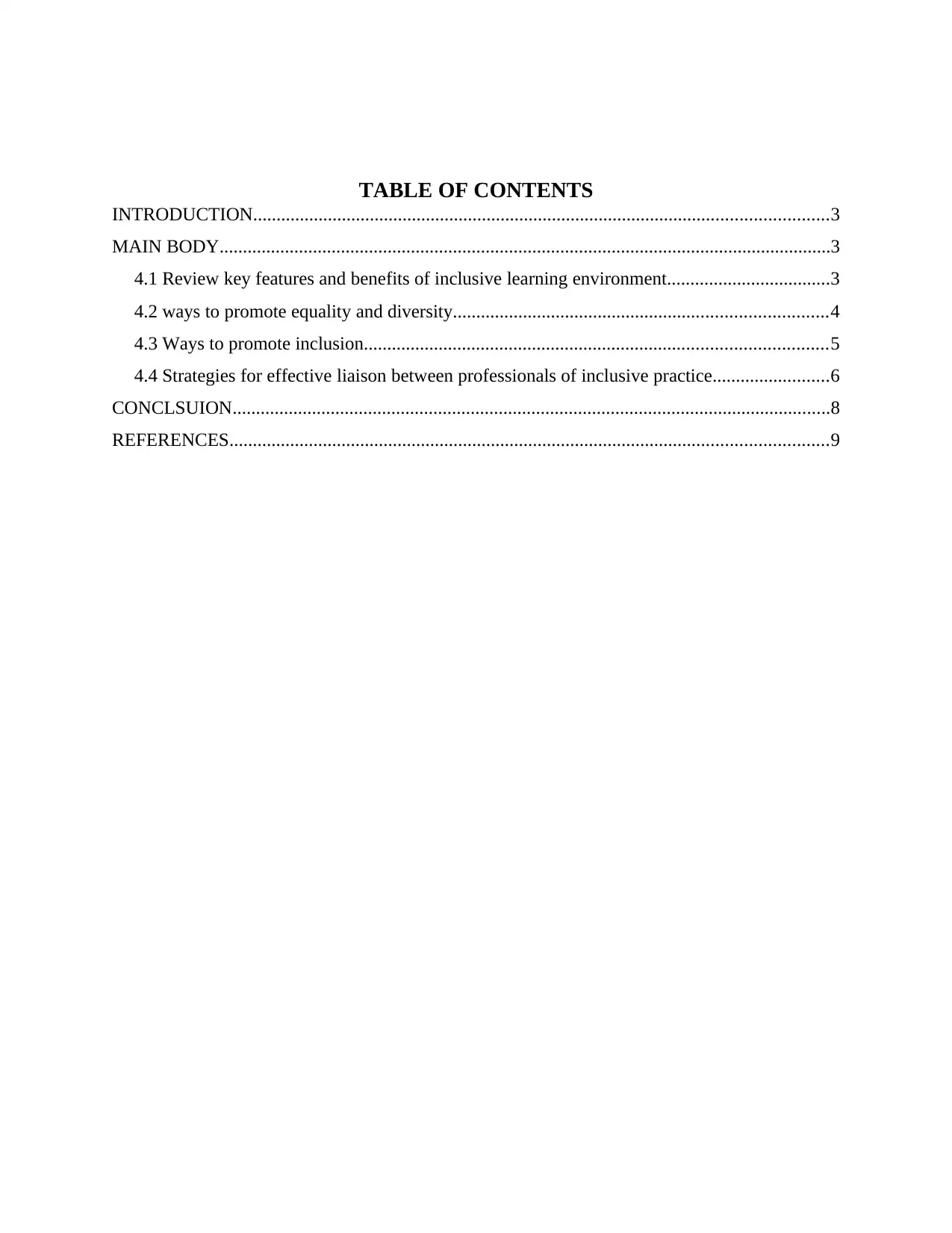
TABLE OF CONTENTS
INTRODUCTION...........................................................................................................................3
MAIN BODY...................................................................................................................................3
4.1 Review key features and benefits of inclusive learning environment...................................3
4.2 ways to promote equality and diversity................................................................................4
4.3 Ways to promote inclusion...................................................................................................5
4.4 Strategies for effective liaison between professionals of inclusive practice.........................6
CONCLSUION................................................................................................................................8
REFERENCES................................................................................................................................9
INTRODUCTION...........................................................................................................................3
MAIN BODY...................................................................................................................................3
4.1 Review key features and benefits of inclusive learning environment...................................3
4.2 ways to promote equality and diversity................................................................................4
4.3 Ways to promote inclusion...................................................................................................5
4.4 Strategies for effective liaison between professionals of inclusive practice.........................6
CONCLSUION................................................................................................................................8
REFERENCES................................................................................................................................9
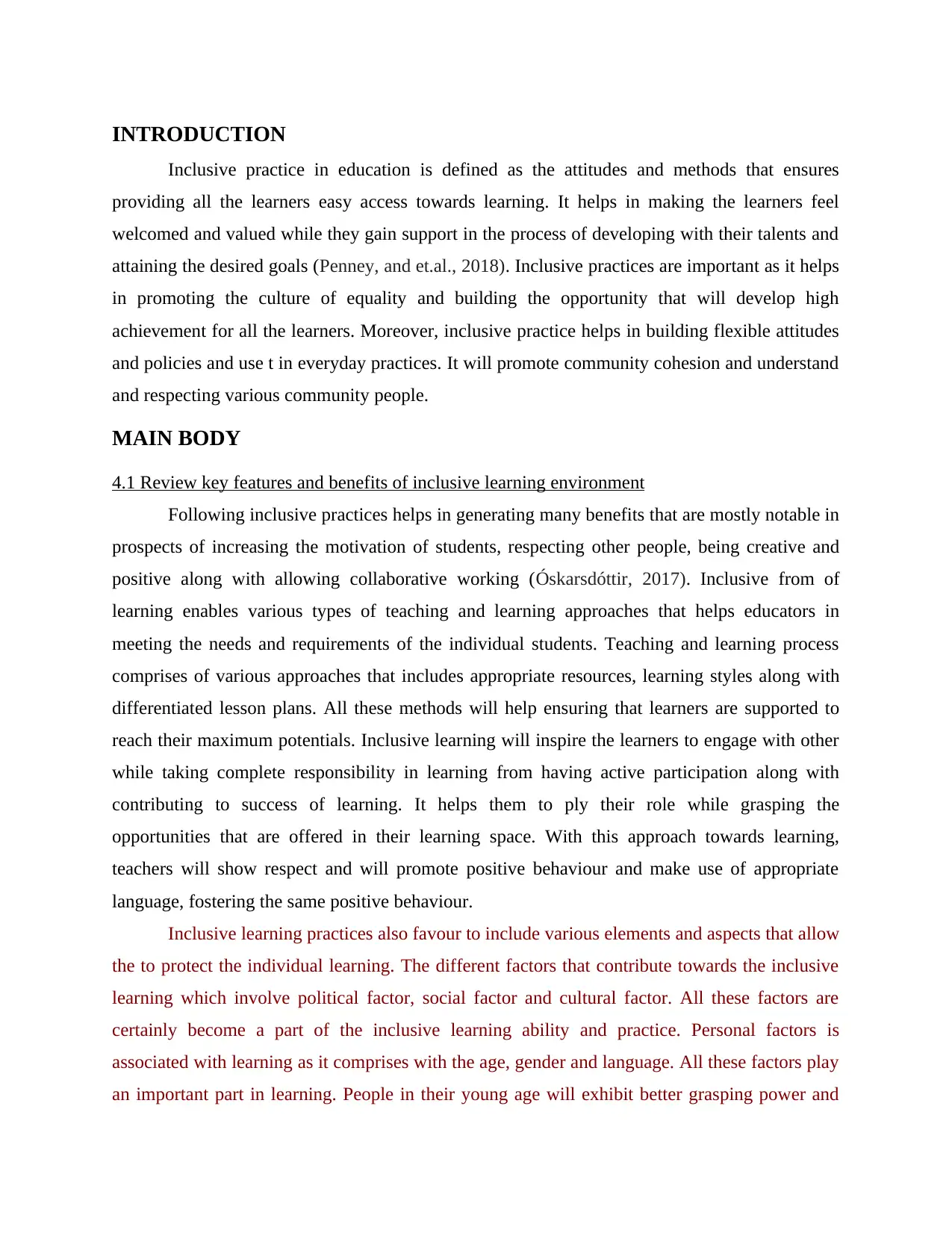
INTRODUCTION
Inclusive practice in education is defined as the attitudes and methods that ensures
providing all the learners easy access towards learning. It helps in making the learners feel
welcomed and valued while they gain support in the process of developing with their talents and
attaining the desired goals (Penney, and et.al., 2018). Inclusive practices are important as it helps
in promoting the culture of equality and building the opportunity that will develop high
achievement for all the learners. Moreover, inclusive practice helps in building flexible attitudes
and policies and use t in everyday practices. It will promote community cohesion and understand
and respecting various community people.
MAIN BODY
4.1 Review key features and benefits of inclusive learning environment
Following inclusive practices helps in generating many benefits that are mostly notable in
prospects of increasing the motivation of students, respecting other people, being creative and
positive along with allowing collaborative working (Óskarsdóttir, 2017). Inclusive from of
learning enables various types of teaching and learning approaches that helps educators in
meeting the needs and requirements of the individual students. Teaching and learning process
comprises of various approaches that includes appropriate resources, learning styles along with
differentiated lesson plans. All these methods will help ensuring that learners are supported to
reach their maximum potentials. Inclusive learning will inspire the learners to engage with other
while taking complete responsibility in learning from having active participation along with
contributing to success of learning. It helps them to ply their role while grasping the
opportunities that are offered in their learning space. With this approach towards learning,
teachers will show respect and will promote positive behaviour and make use of appropriate
language, fostering the same positive behaviour.
Inclusive learning practices also favour to include various elements and aspects that allow
the to protect the individual learning. The different factors that contribute towards the inclusive
learning which involve political factor, social factor and cultural factor. All these factors are
certainly become a part of the inclusive learning ability and practice. Personal factors is
associated with learning as it comprises with the age, gender and language. All these factors play
an important part in learning. People in their young age will exhibit better grasping power and
Inclusive practice in education is defined as the attitudes and methods that ensures
providing all the learners easy access towards learning. It helps in making the learners feel
welcomed and valued while they gain support in the process of developing with their talents and
attaining the desired goals (Penney, and et.al., 2018). Inclusive practices are important as it helps
in promoting the culture of equality and building the opportunity that will develop high
achievement for all the learners. Moreover, inclusive practice helps in building flexible attitudes
and policies and use t in everyday practices. It will promote community cohesion and understand
and respecting various community people.
MAIN BODY
4.1 Review key features and benefits of inclusive learning environment
Following inclusive practices helps in generating many benefits that are mostly notable in
prospects of increasing the motivation of students, respecting other people, being creative and
positive along with allowing collaborative working (Óskarsdóttir, 2017). Inclusive from of
learning enables various types of teaching and learning approaches that helps educators in
meeting the needs and requirements of the individual students. Teaching and learning process
comprises of various approaches that includes appropriate resources, learning styles along with
differentiated lesson plans. All these methods will help ensuring that learners are supported to
reach their maximum potentials. Inclusive learning will inspire the learners to engage with other
while taking complete responsibility in learning from having active participation along with
contributing to success of learning. It helps them to ply their role while grasping the
opportunities that are offered in their learning space. With this approach towards learning,
teachers will show respect and will promote positive behaviour and make use of appropriate
language, fostering the same positive behaviour.
Inclusive learning practices also favour to include various elements and aspects that allow
the to protect the individual learning. The different factors that contribute towards the inclusive
learning which involve political factor, social factor and cultural factor. All these factors are
certainly become a part of the inclusive learning ability and practice. Personal factors is
associated with learning as it comprises with the age, gender and language. All these factors play
an important part in learning. People in their young age will exhibit better grasping power and
⊘ This is a preview!⊘
Do you want full access?
Subscribe today to unlock all pages.

Trusted by 1+ million students worldwide
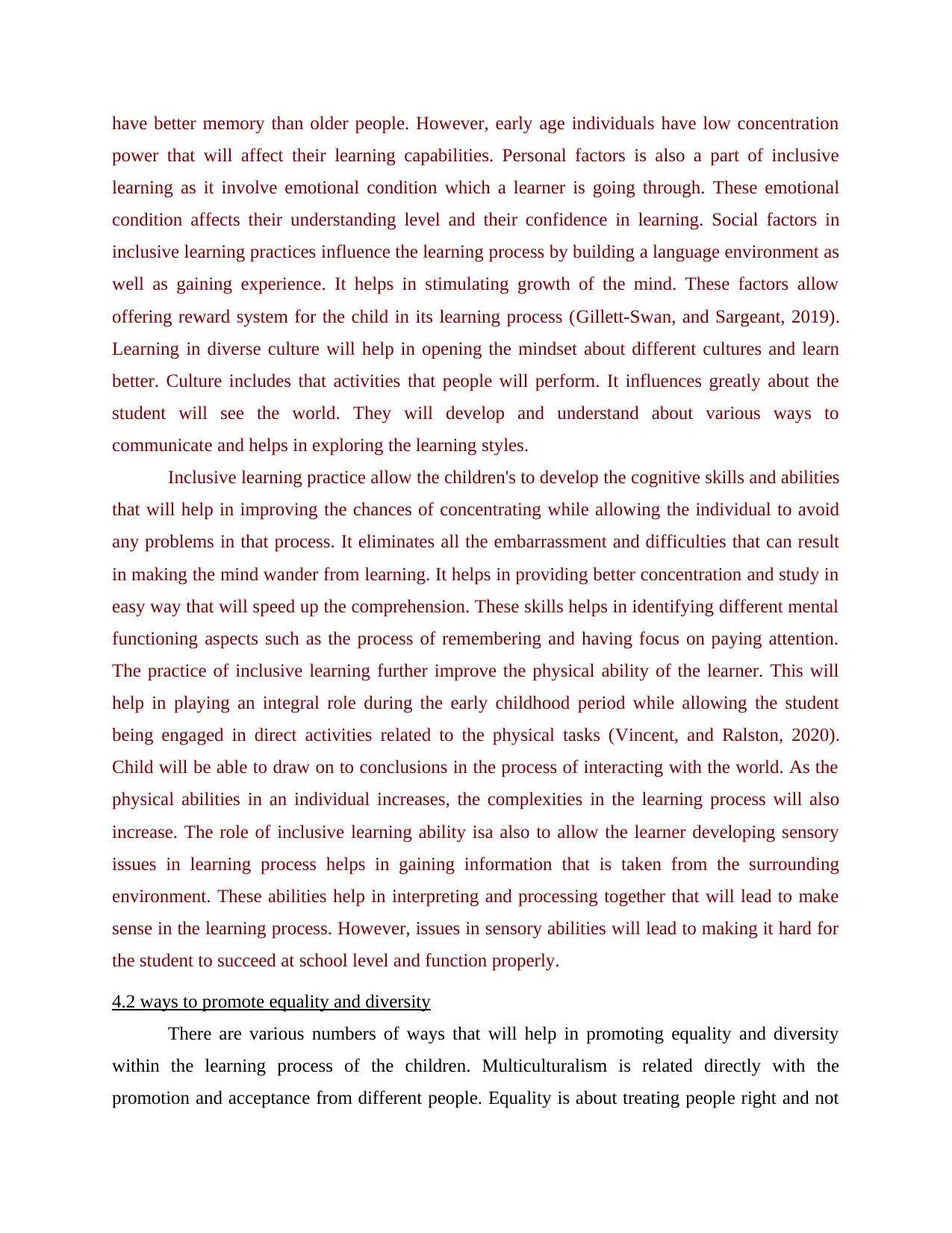
have better memory than older people. However, early age individuals have low concentration
power that will affect their learning capabilities. Personal factors is also a part of inclusive
learning as it involve emotional condition which a learner is going through. These emotional
condition affects their understanding level and their confidence in learning. Social factors in
inclusive learning practices influence the learning process by building a language environment as
well as gaining experience. It helps in stimulating growth of the mind. These factors allow
offering reward system for the child in its learning process (Gillett-Swan, and Sargeant, 2019).
Learning in diverse culture will help in opening the mindset about different cultures and learn
better. Culture includes that activities that people will perform. It influences greatly about the
student will see the world. They will develop and understand about various ways to
communicate and helps in exploring the learning styles.
Inclusive learning practice allow the children's to develop the cognitive skills and abilities
that will help in improving the chances of concentrating while allowing the individual to avoid
any problems in that process. It eliminates all the embarrassment and difficulties that can result
in making the mind wander from learning. It helps in providing better concentration and study in
easy way that will speed up the comprehension. These skills helps in identifying different mental
functioning aspects such as the process of remembering and having focus on paying attention.
The practice of inclusive learning further improve the physical ability of the learner. This will
help in playing an integral role during the early childhood period while allowing the student
being engaged in direct activities related to the physical tasks (Vincent, and Ralston, 2020).
Child will be able to draw on to conclusions in the process of interacting with the world. As the
physical abilities in an individual increases, the complexities in the learning process will also
increase. The role of inclusive learning ability isa also to allow the learner developing sensory
issues in learning process helps in gaining information that is taken from the surrounding
environment. These abilities help in interpreting and processing together that will lead to make
sense in the learning process. However, issues in sensory abilities will lead to making it hard for
the student to succeed at school level and function properly.
4.2 ways to promote equality and diversity
There are various numbers of ways that will help in promoting equality and diversity
within the learning process of the children. Multiculturalism is related directly with the
promotion and acceptance from different people. Equality is about treating people right and not
power that will affect their learning capabilities. Personal factors is also a part of inclusive
learning as it involve emotional condition which a learner is going through. These emotional
condition affects their understanding level and their confidence in learning. Social factors in
inclusive learning practices influence the learning process by building a language environment as
well as gaining experience. It helps in stimulating growth of the mind. These factors allow
offering reward system for the child in its learning process (Gillett-Swan, and Sargeant, 2019).
Learning in diverse culture will help in opening the mindset about different cultures and learn
better. Culture includes that activities that people will perform. It influences greatly about the
student will see the world. They will develop and understand about various ways to
communicate and helps in exploring the learning styles.
Inclusive learning practice allow the children's to develop the cognitive skills and abilities
that will help in improving the chances of concentrating while allowing the individual to avoid
any problems in that process. It eliminates all the embarrassment and difficulties that can result
in making the mind wander from learning. It helps in providing better concentration and study in
easy way that will speed up the comprehension. These skills helps in identifying different mental
functioning aspects such as the process of remembering and having focus on paying attention.
The practice of inclusive learning further improve the physical ability of the learner. This will
help in playing an integral role during the early childhood period while allowing the student
being engaged in direct activities related to the physical tasks (Vincent, and Ralston, 2020).
Child will be able to draw on to conclusions in the process of interacting with the world. As the
physical abilities in an individual increases, the complexities in the learning process will also
increase. The role of inclusive learning ability isa also to allow the learner developing sensory
issues in learning process helps in gaining information that is taken from the surrounding
environment. These abilities help in interpreting and processing together that will lead to make
sense in the learning process. However, issues in sensory abilities will lead to making it hard for
the student to succeed at school level and function properly.
4.2 ways to promote equality and diversity
There are various numbers of ways that will help in promoting equality and diversity
within the learning process of the children. Multiculturalism is related directly with the
promotion and acceptance from different people. Equality is about treating people right and not
Paraphrase This Document
Need a fresh take? Get an instant paraphrase of this document with our AI Paraphraser
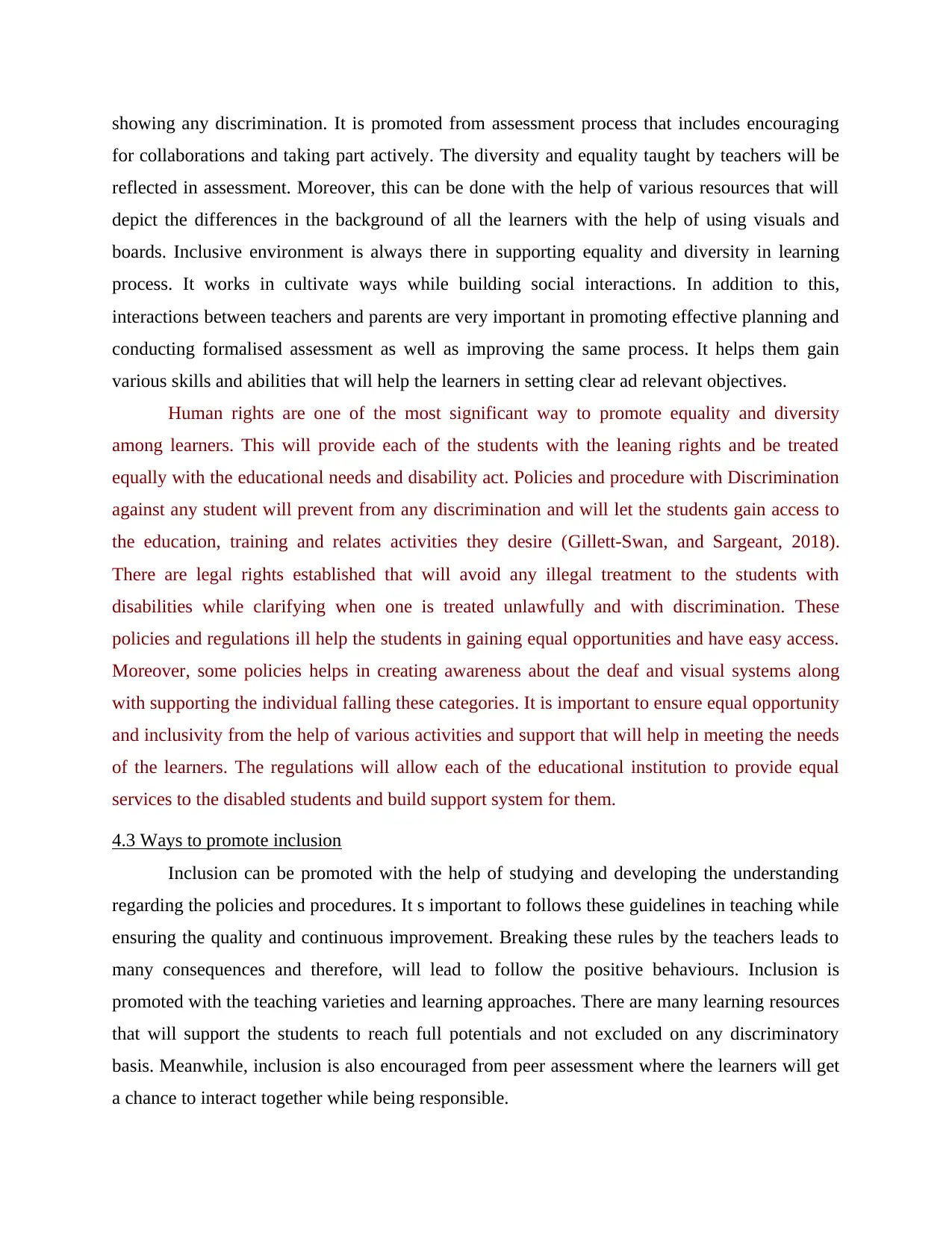
showing any discrimination. It is promoted from assessment process that includes encouraging
for collaborations and taking part actively. The diversity and equality taught by teachers will be
reflected in assessment. Moreover, this can be done with the help of various resources that will
depict the differences in the background of all the learners with the help of using visuals and
boards. Inclusive environment is always there in supporting equality and diversity in learning
process. It works in cultivate ways while building social interactions. In addition to this,
interactions between teachers and parents are very important in promoting effective planning and
conducting formalised assessment as well as improving the same process. It helps them gain
various skills and abilities that will help the learners in setting clear ad relevant objectives.
Human rights are one of the most significant way to promote equality and diversity
among learners. This will provide each of the students with the leaning rights and be treated
equally with the educational needs and disability act. Policies and procedure with Discrimination
against any student will prevent from any discrimination and will let the students gain access to
the education, training and relates activities they desire (Gillett‐Swan, and Sargeant, 2018).
There are legal rights established that will avoid any illegal treatment to the students with
disabilities while clarifying when one is treated unlawfully and with discrimination. These
policies and regulations ill help the students in gaining equal opportunities and have easy access.
Moreover, some policies helps in creating awareness about the deaf and visual systems along
with supporting the individual falling these categories. It is important to ensure equal opportunity
and inclusivity from the help of various activities and support that will help in meeting the needs
of the learners. The regulations will allow each of the educational institution to provide equal
services to the disabled students and build support system for them.
4.3 Ways to promote inclusion
Inclusion can be promoted with the help of studying and developing the understanding
regarding the policies and procedures. It s important to follows these guidelines in teaching while
ensuring the quality and continuous improvement. Breaking these rules by the teachers leads to
many consequences and therefore, will lead to follow the positive behaviours. Inclusion is
promoted with the teaching varieties and learning approaches. There are many learning resources
that will support the students to reach full potentials and not excluded on any discriminatory
basis. Meanwhile, inclusion is also encouraged from peer assessment where the learners will get
a chance to interact together while being responsible.
for collaborations and taking part actively. The diversity and equality taught by teachers will be
reflected in assessment. Moreover, this can be done with the help of various resources that will
depict the differences in the background of all the learners with the help of using visuals and
boards. Inclusive environment is always there in supporting equality and diversity in learning
process. It works in cultivate ways while building social interactions. In addition to this,
interactions between teachers and parents are very important in promoting effective planning and
conducting formalised assessment as well as improving the same process. It helps them gain
various skills and abilities that will help the learners in setting clear ad relevant objectives.
Human rights are one of the most significant way to promote equality and diversity
among learners. This will provide each of the students with the leaning rights and be treated
equally with the educational needs and disability act. Policies and procedure with Discrimination
against any student will prevent from any discrimination and will let the students gain access to
the education, training and relates activities they desire (Gillett‐Swan, and Sargeant, 2018).
There are legal rights established that will avoid any illegal treatment to the students with
disabilities while clarifying when one is treated unlawfully and with discrimination. These
policies and regulations ill help the students in gaining equal opportunities and have easy access.
Moreover, some policies helps in creating awareness about the deaf and visual systems along
with supporting the individual falling these categories. It is important to ensure equal opportunity
and inclusivity from the help of various activities and support that will help in meeting the needs
of the learners. The regulations will allow each of the educational institution to provide equal
services to the disabled students and build support system for them.
4.3 Ways to promote inclusion
Inclusion can be promoted with the help of studying and developing the understanding
regarding the policies and procedures. It s important to follows these guidelines in teaching while
ensuring the quality and continuous improvement. Breaking these rules by the teachers leads to
many consequences and therefore, will lead to follow the positive behaviours. Inclusion is
promoted with the teaching varieties and learning approaches. There are many learning resources
that will support the students to reach full potentials and not excluded on any discriminatory
basis. Meanwhile, inclusion is also encouraged from peer assessment where the learners will get
a chance to interact together while being responsible.
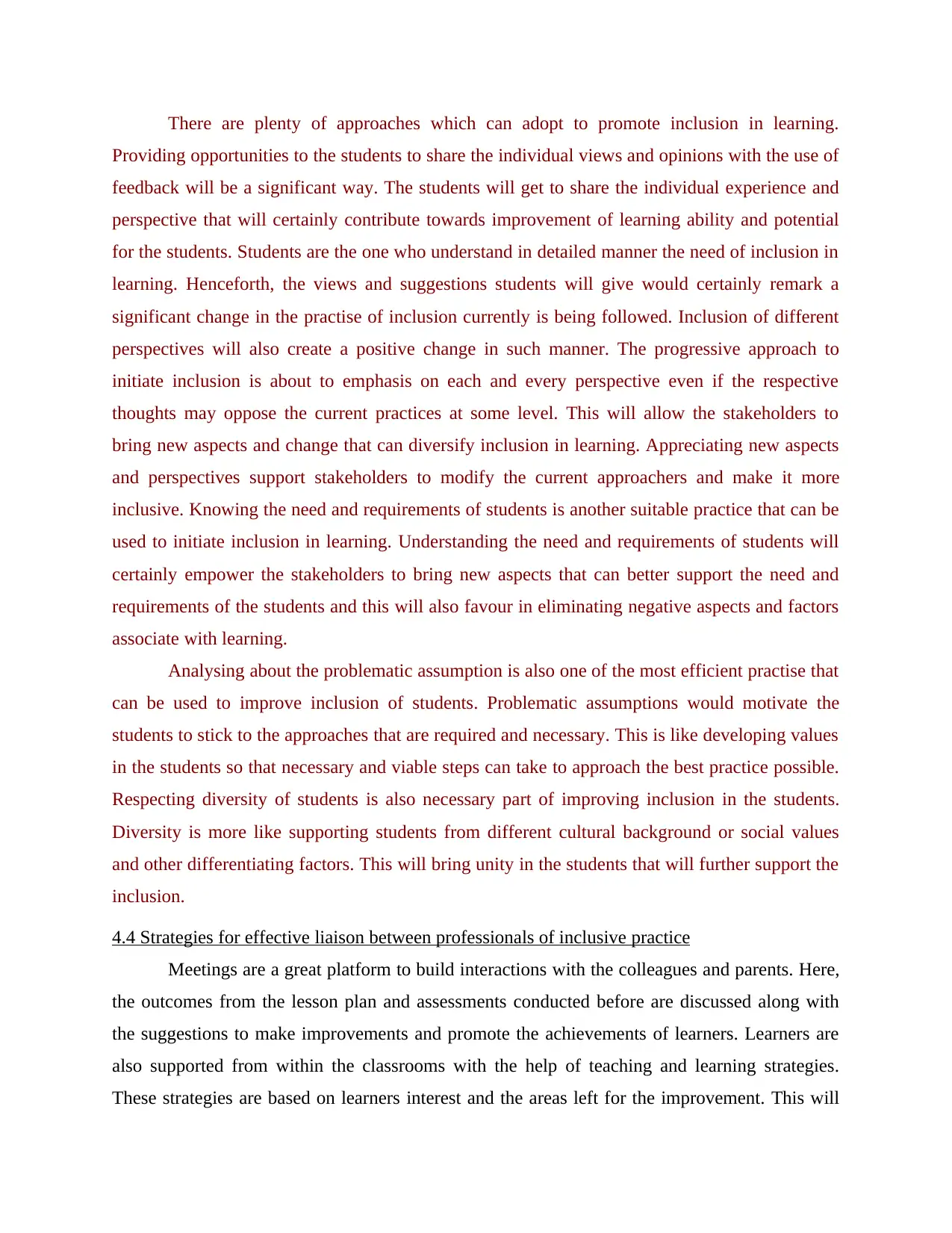
There are plenty of approaches which can adopt to promote inclusion in learning.
Providing opportunities to the students to share the individual views and opinions with the use of
feedback will be a significant way. The students will get to share the individual experience and
perspective that will certainly contribute towards improvement of learning ability and potential
for the students. Students are the one who understand in detailed manner the need of inclusion in
learning. Henceforth, the views and suggestions students will give would certainly remark a
significant change in the practise of inclusion currently is being followed. Inclusion of different
perspectives will also create a positive change in such manner. The progressive approach to
initiate inclusion is about to emphasis on each and every perspective even if the respective
thoughts may oppose the current practices at some level. This will allow the stakeholders to
bring new aspects and change that can diversify inclusion in learning. Appreciating new aspects
and perspectives support stakeholders to modify the current approachers and make it more
inclusive. Knowing the need and requirements of students is another suitable practice that can be
used to initiate inclusion in learning. Understanding the need and requirements of students will
certainly empower the stakeholders to bring new aspects that can better support the need and
requirements of the students and this will also favour in eliminating negative aspects and factors
associate with learning.
Analysing about the problematic assumption is also one of the most efficient practise that
can be used to improve inclusion of students. Problematic assumptions would motivate the
students to stick to the approaches that are required and necessary. This is like developing values
in the students so that necessary and viable steps can take to approach the best practice possible.
Respecting diversity of students is also necessary part of improving inclusion in the students.
Diversity is more like supporting students from different cultural background or social values
and other differentiating factors. This will bring unity in the students that will further support the
inclusion.
4.4 Strategies for effective liaison between professionals of inclusive practice
Meetings are a great platform to build interactions with the colleagues and parents. Here,
the outcomes from the lesson plan and assessments conducted before are discussed along with
the suggestions to make improvements and promote the achievements of learners. Learners are
also supported from within the classrooms with the help of teaching and learning strategies.
These strategies are based on learners interest and the areas left for the improvement. This will
Providing opportunities to the students to share the individual views and opinions with the use of
feedback will be a significant way. The students will get to share the individual experience and
perspective that will certainly contribute towards improvement of learning ability and potential
for the students. Students are the one who understand in detailed manner the need of inclusion in
learning. Henceforth, the views and suggestions students will give would certainly remark a
significant change in the practise of inclusion currently is being followed. Inclusion of different
perspectives will also create a positive change in such manner. The progressive approach to
initiate inclusion is about to emphasis on each and every perspective even if the respective
thoughts may oppose the current practices at some level. This will allow the stakeholders to
bring new aspects and change that can diversify inclusion in learning. Appreciating new aspects
and perspectives support stakeholders to modify the current approachers and make it more
inclusive. Knowing the need and requirements of students is another suitable practice that can be
used to initiate inclusion in learning. Understanding the need and requirements of students will
certainly empower the stakeholders to bring new aspects that can better support the need and
requirements of the students and this will also favour in eliminating negative aspects and factors
associate with learning.
Analysing about the problematic assumption is also one of the most efficient practise that
can be used to improve inclusion of students. Problematic assumptions would motivate the
students to stick to the approaches that are required and necessary. This is like developing values
in the students so that necessary and viable steps can take to approach the best practice possible.
Respecting diversity of students is also necessary part of improving inclusion in the students.
Diversity is more like supporting students from different cultural background or social values
and other differentiating factors. This will bring unity in the students that will further support the
inclusion.
4.4 Strategies for effective liaison between professionals of inclusive practice
Meetings are a great platform to build interactions with the colleagues and parents. Here,
the outcomes from the lesson plan and assessments conducted before are discussed along with
the suggestions to make improvements and promote the achievements of learners. Learners are
also supported from within the classrooms with the help of teaching and learning strategies.
These strategies are based on learners interest and the areas left for the improvement. This will
⊘ This is a preview!⊘
Do you want full access?
Subscribe today to unlock all pages.

Trusted by 1+ million students worldwide
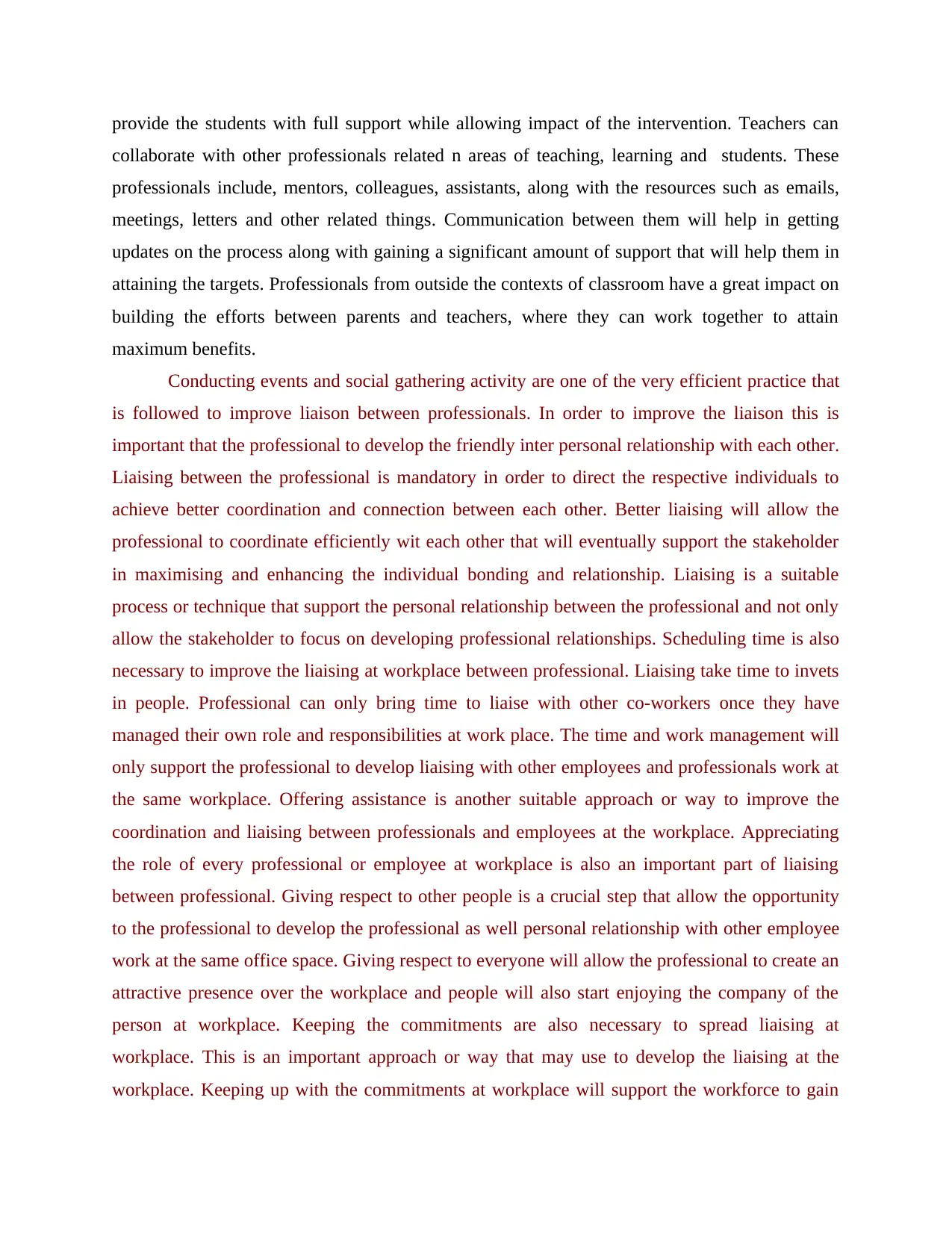
provide the students with full support while allowing impact of the intervention. Teachers can
collaborate with other professionals related n areas of teaching, learning and students. These
professionals include, mentors, colleagues, assistants, along with the resources such as emails,
meetings, letters and other related things. Communication between them will help in getting
updates on the process along with gaining a significant amount of support that will help them in
attaining the targets. Professionals from outside the contexts of classroom have a great impact on
building the efforts between parents and teachers, where they can work together to attain
maximum benefits.
Conducting events and social gathering activity are one of the very efficient practice that
is followed to improve liaison between professionals. In order to improve the liaison this is
important that the professional to develop the friendly inter personal relationship with each other.
Liaising between the professional is mandatory in order to direct the respective individuals to
achieve better coordination and connection between each other. Better liaising will allow the
professional to coordinate efficiently wit each other that will eventually support the stakeholder
in maximising and enhancing the individual bonding and relationship. Liaising is a suitable
process or technique that support the personal relationship between the professional and not only
allow the stakeholder to focus on developing professional relationships. Scheduling time is also
necessary to improve the liaising at workplace between professional. Liaising take time to invets
in people. Professional can only bring time to liaise with other co-workers once they have
managed their own role and responsibilities at work place. The time and work management will
only support the professional to develop liaising with other employees and professionals work at
the same workplace. Offering assistance is another suitable approach or way to improve the
coordination and liaising between professionals and employees at the workplace. Appreciating
the role of every professional or employee at workplace is also an important part of liaising
between professional. Giving respect to other people is a crucial step that allow the opportunity
to the professional to develop the professional as well personal relationship with other employee
work at the same office space. Giving respect to everyone will allow the professional to create an
attractive presence over the workplace and people will also start enjoying the company of the
person at workplace. Keeping the commitments are also necessary to spread liaising at
workplace. This is an important approach or way that may use to develop the liaising at the
workplace. Keeping up with the commitments at workplace will support the workforce to gain
collaborate with other professionals related n areas of teaching, learning and students. These
professionals include, mentors, colleagues, assistants, along with the resources such as emails,
meetings, letters and other related things. Communication between them will help in getting
updates on the process along with gaining a significant amount of support that will help them in
attaining the targets. Professionals from outside the contexts of classroom have a great impact on
building the efforts between parents and teachers, where they can work together to attain
maximum benefits.
Conducting events and social gathering activity are one of the very efficient practice that
is followed to improve liaison between professionals. In order to improve the liaison this is
important that the professional to develop the friendly inter personal relationship with each other.
Liaising between the professional is mandatory in order to direct the respective individuals to
achieve better coordination and connection between each other. Better liaising will allow the
professional to coordinate efficiently wit each other that will eventually support the stakeholder
in maximising and enhancing the individual bonding and relationship. Liaising is a suitable
process or technique that support the personal relationship between the professional and not only
allow the stakeholder to focus on developing professional relationships. Scheduling time is also
necessary to improve the liaising at workplace between professional. Liaising take time to invets
in people. Professional can only bring time to liaise with other co-workers once they have
managed their own role and responsibilities at work place. The time and work management will
only support the professional to develop liaising with other employees and professionals work at
the same workplace. Offering assistance is another suitable approach or way to improve the
coordination and liaising between professionals and employees at the workplace. Appreciating
the role of every professional or employee at workplace is also an important part of liaising
between professional. Giving respect to other people is a crucial step that allow the opportunity
to the professional to develop the professional as well personal relationship with other employee
work at the same office space. Giving respect to everyone will allow the professional to create an
attractive presence over the workplace and people will also start enjoying the company of the
person at workplace. Keeping the commitments are also necessary to spread liaising at
workplace. This is an important approach or way that may use to develop the liaising at the
workplace. Keeping up with the commitments at workplace will support the workforce to gain
Paraphrase This Document
Need a fresh take? Get an instant paraphrase of this document with our AI Paraphraser
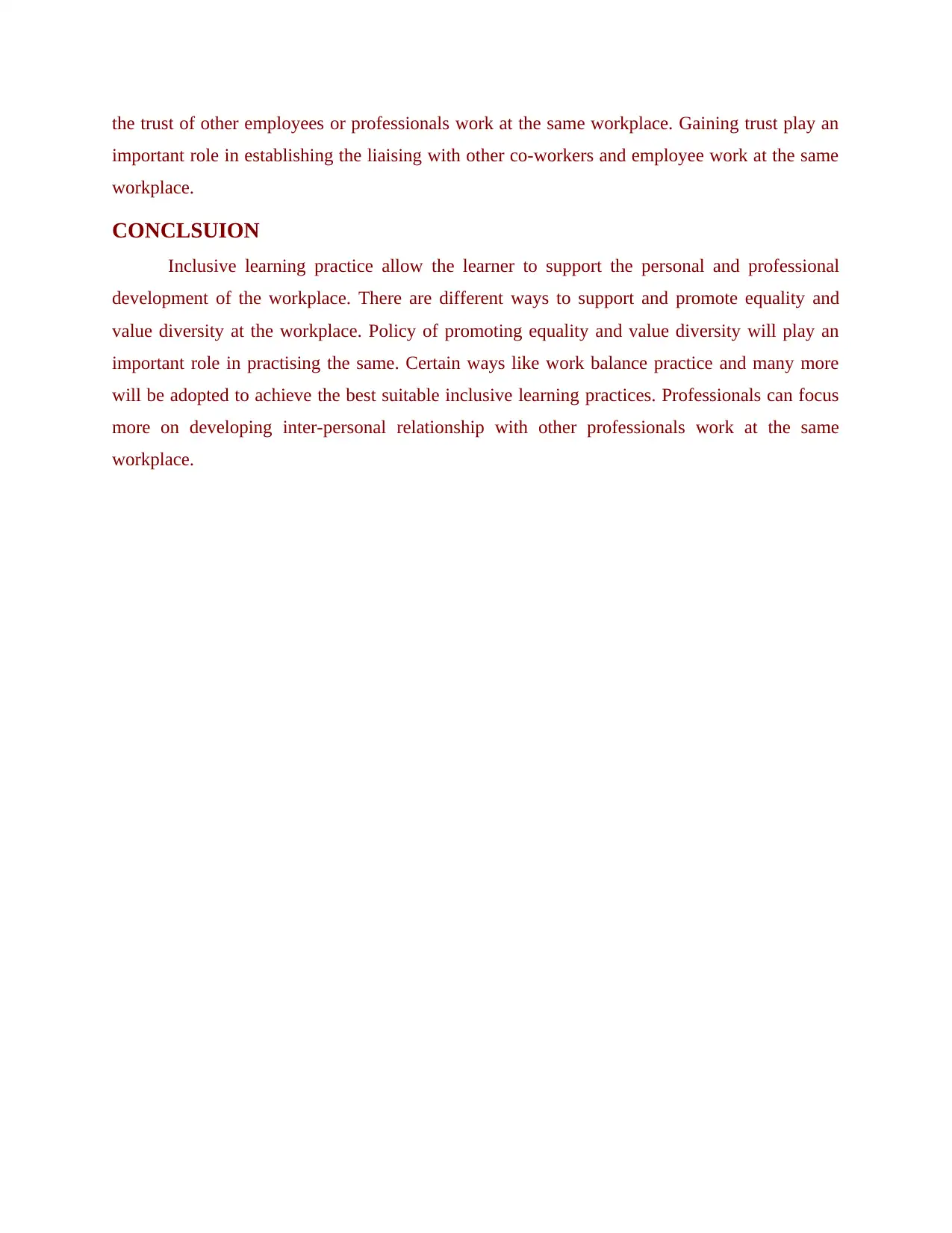
the trust of other employees or professionals work at the same workplace. Gaining trust play an
important role in establishing the liaising with other co-workers and employee work at the same
workplace.
CONCLSUION
Inclusive learning practice allow the learner to support the personal and professional
development of the workplace. There are different ways to support and promote equality and
value diversity at the workplace. Policy of promoting equality and value diversity will play an
important role in practising the same. Certain ways like work balance practice and many more
will be adopted to achieve the best suitable inclusive learning practices. Professionals can focus
more on developing inter-personal relationship with other professionals work at the same
workplace.
important role in establishing the liaising with other co-workers and employee work at the same
workplace.
CONCLSUION
Inclusive learning practice allow the learner to support the personal and professional
development of the workplace. There are different ways to support and promote equality and
value diversity at the workplace. Policy of promoting equality and value diversity will play an
important role in practising the same. Certain ways like work balance practice and many more
will be adopted to achieve the best suitable inclusive learning practices. Professionals can focus
more on developing inter-personal relationship with other professionals work at the same
workplace.
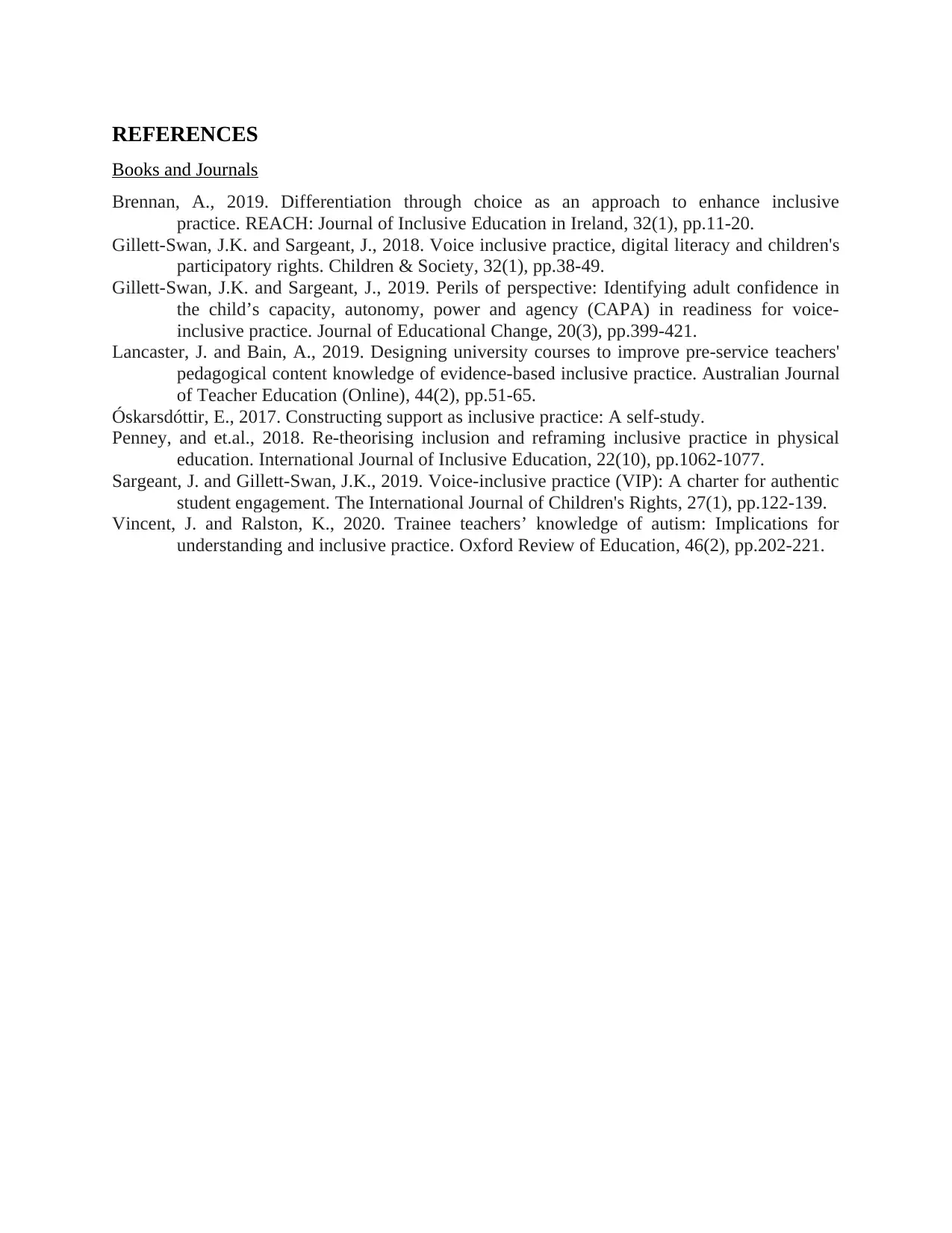
REFERENCES
Books and Journals
Brennan, A., 2019. Differentiation through choice as an approach to enhance inclusive
practice. REACH: Journal of Inclusive Education in Ireland, 32(1), pp.11-20.
Gillett‐Swan, J.K. and Sargeant, J., 2018. Voice inclusive practice, digital literacy and children's
participatory rights. Children & Society, 32(1), pp.38-49.
Gillett-Swan, J.K. and Sargeant, J., 2019. Perils of perspective: Identifying adult confidence in
the child’s capacity, autonomy, power and agency (CAPA) in readiness for voice-
inclusive practice. Journal of Educational Change, 20(3), pp.399-421.
Lancaster, J. and Bain, A., 2019. Designing university courses to improve pre-service teachers'
pedagogical content knowledge of evidence-based inclusive practice. Australian Journal
of Teacher Education (Online), 44(2), pp.51-65.
Óskarsdóttir, E., 2017. Constructing support as inclusive practice: A self-study.
Penney, and et.al., 2018. Re-theorising inclusion and reframing inclusive practice in physical
education. International Journal of Inclusive Education, 22(10), pp.1062-1077.
Sargeant, J. and Gillett-Swan, J.K., 2019. Voice-inclusive practice (VIP): A charter for authentic
student engagement. The International Journal of Children's Rights, 27(1), pp.122-139.
Vincent, J. and Ralston, K., 2020. Trainee teachers’ knowledge of autism: Implications for
understanding and inclusive practice. Oxford Review of Education, 46(2), pp.202-221.
Books and Journals
Brennan, A., 2019. Differentiation through choice as an approach to enhance inclusive
practice. REACH: Journal of Inclusive Education in Ireland, 32(1), pp.11-20.
Gillett‐Swan, J.K. and Sargeant, J., 2018. Voice inclusive practice, digital literacy and children's
participatory rights. Children & Society, 32(1), pp.38-49.
Gillett-Swan, J.K. and Sargeant, J., 2019. Perils of perspective: Identifying adult confidence in
the child’s capacity, autonomy, power and agency (CAPA) in readiness for voice-
inclusive practice. Journal of Educational Change, 20(3), pp.399-421.
Lancaster, J. and Bain, A., 2019. Designing university courses to improve pre-service teachers'
pedagogical content knowledge of evidence-based inclusive practice. Australian Journal
of Teacher Education (Online), 44(2), pp.51-65.
Óskarsdóttir, E., 2017. Constructing support as inclusive practice: A self-study.
Penney, and et.al., 2018. Re-theorising inclusion and reframing inclusive practice in physical
education. International Journal of Inclusive Education, 22(10), pp.1062-1077.
Sargeant, J. and Gillett-Swan, J.K., 2019. Voice-inclusive practice (VIP): A charter for authentic
student engagement. The International Journal of Children's Rights, 27(1), pp.122-139.
Vincent, J. and Ralston, K., 2020. Trainee teachers’ knowledge of autism: Implications for
understanding and inclusive practice. Oxford Review of Education, 46(2), pp.202-221.
⊘ This is a preview!⊘
Do you want full access?
Subscribe today to unlock all pages.

Trusted by 1+ million students worldwide
1 out of 9
Related Documents
Your All-in-One AI-Powered Toolkit for Academic Success.
+13062052269
info@desklib.com
Available 24*7 on WhatsApp / Email
![[object Object]](/_next/static/media/star-bottom.7253800d.svg)
Unlock your academic potential
Copyright © 2020–2025 A2Z Services. All Rights Reserved. Developed and managed by ZUCOL.



